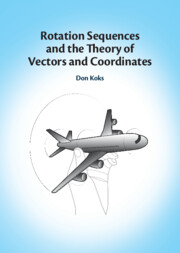Book contents
- Frontmatter
- Contents
- Preface
- 1 Setting the Scene
- 2 Trigonometry, the Foundation of Coordinate Theory
- 3 The Vector Dot and Cross Products
- 4 Vector Preliminaries and Constructing a Basis
- 5 Converting Vector Coordinates Across Bases
- 6 Vector Rotation in Two and Three Dimensions
- 7 Rotation Sequences and the Fundamental Theorem
- 8 Coordinate Systems for Earth, and More Rotation Sequences
- 9 The Role of Quaternions in Rotation Theory
- 10 Time Dependence of Vehicle Attitude
- 11 Frame Dependence of the Time Derivative
- 12 Earth’s Orientation in Space, and Time on Earth
- 13 Orbital Mechanics
- 14 Rigid-Body Dynamics
- 15 Modelling the Motion and Attitude of a Vehicle
- 16 Concepts of Tensor Analysis
- Index
4 - Vector Preliminaries and Constructing a Basis
Published online by Cambridge University Press: 17 April 2025
- Frontmatter
- Contents
- Preface
- 1 Setting the Scene
- 2 Trigonometry, the Foundation of Coordinate Theory
- 3 The Vector Dot and Cross Products
- 4 Vector Preliminaries and Constructing a Basis
- 5 Converting Vector Coordinates Across Bases
- 6 Vector Rotation in Two and Three Dimensions
- 7 Rotation Sequences and the Fundamental Theorem
- 8 Coordinate Systems for Earth, and More Rotation Sequences
- 9 The Role of Quaternions in Rotation Theory
- 10 Time Dependence of Vehicle Attitude
- 11 Frame Dependence of the Time Derivative
- 12 Earth’s Orientation in Space, and Time on Earth
- 13 Orbital Mechanics
- 14 Rigid-Body Dynamics
- 15 Modelling the Motion and Attitude of a Vehicle
- 16 Concepts of Tensor Analysis
- Index
Summary
I start by invoking the ‘fundamental rule of calculus notation’ to ensure the correct translation of an English sentence into the language of calculus. As examples, I derive the ‘rocket equation’ and the standard expression for the gravitational potential of a sphere. I discuss the importance of treating units properly. I make the important point that a frame is not the same as a system of coordinates. I distinguish between ‘proper vectors’ and ‘coordinates vectors’, which is needed for a proper understanding of transforming coordinates. Because the study of vehicle attitude is built on basis vectors, I show how to construct these from both an intuitive viewpoint and a purely mathematical viewpoint.
- Type
- Chapter
- Information
- Rotation Sequences and the Theory of Vectors and Coordinates , pp. 69 - 105Publisher: Cambridge University PressPrint publication year: 2025

